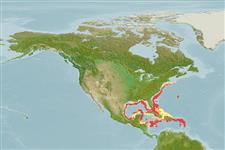Environment: milieu / climate zone / depth range / distribution range
Ecologie
marien demersaal; diepte 100 - 724 m (Ref. 13203), usually 315 - 724 m (Ref. 13203). Subtropical; 41°N - 14°N
Western Atlantic: New York and northern Gulf of Mexico in USA to West Indies; southern limit uncertain
Grootte / Gewicht / Leeftijd
Maturity: Lm ? range ? - ? cm
Max length : 30.0 cm TL mannelijk / geslacht onbekend; (Ref. 7251)
Dorsale stekels (totaal) : 6; Dorsale zachte stralen (totaal) : 16 - 17; Anale zachte stralen: 17 - 18. Membrane between first and second spines of first dorsal fin dark gray. Snout relatively short (1.0-1.2x eye diameter). Scales present on lateral and dorsal surfaces of snout. Upper jaw extending behind anterior margin of eye. Maxillary tentacle short and stumpy. Lateral line descending relatively abruptly beyond origin of pectoral fin, separated from origin of first dorsal fin by 4-6 rows of scales, from origin of anal fin by 5 or 6, and from insertion of anal fin by 3. No evidence of prolongation of any spine of first dorsal fin. Predorsal length for first dorsal fin almost equal to head length. Color in alcohol darker gray dorsally, lighter ventrally (Ref 13203).
Enters shelf waters.
Levenscyclus en paargedrag
Maturities | Voortplanting | Spawnings | Egg(s) | Fecundities | Larven
Das, M.K. and J.S. Nelson, 1996. Revision of the percophid genus Bembrops (Actinopterygii: Perciformes). Bull. Mar. Sci. 59(1):9-44. (Ref. 13203)
Status op de Rode Lijst van het IUCN (Ref. 130435)
Gevaar voor de mens
Harmless
Gebruik door de mens
Tools
Speciale rapporten
Download XML
Internetbronnen
Estimates based on models
Preferred temperature (Ref.
123201): 6.5 - 16.4, mean 11.2 °C (based on 146 cells).
Fylogenetische diversiteitsindex (Ref.
82804): PD
50 = 0.5000 [Uniqueness, from 0.5 = low to 2.0 = high].
Bayesian length-weight: a=0.00372 (0.00153 - 0.00904), b=3.10 (2.89 - 3.31), in cm total length, based on LWR estimates for this (Sub)family-body shape (Ref.
93245).
Trofisch niveau (Ref.
69278): 4.1 ±0.5 se; based on size and trophs of closest relatives
Fishing Vulnerability (Ref.
59153): Low vulnerability (20 of 100).
